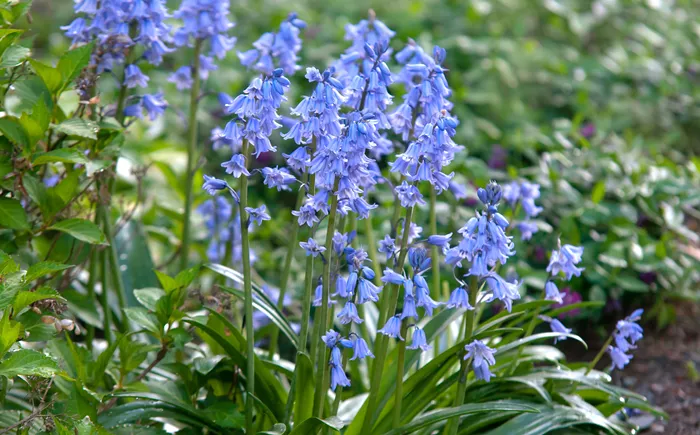Spanish bluebells (Hyacinthoides hispanica) are a beloved addition to many gardens, known for their delicate, bell-shaped flowers and easygoing nature. But before these beautiful blooms appear in spring, their journey starts underground—with their bulbs. Understanding what Spanish bluebell bulbs look like and how to plant and care for them can help ensure a thriving display in your garden.
Identifying Spanish Bluebell Bulbs
Size and Shape
Spanish bluebell bulbs are relatively small, typically ranging between 1 to 1.5 inches (2.5 to 4 cm) in diameter. They are rounded but slightly elongated, resembling a small onion with a somewhat pointed tip.
Color and Texture
The bulbs have a pale, creamy-white to light brown outer skin, often covered in a thin, papery layer similar to that of an onion. When fresh, they are firm and slightly moist. If stored for a while, the outer layers may become drier and more brittle.
Root System and Growth Points
At the base of the bulb, you’ll notice small, wiry root remnants or newly developing roots if it’s in the growing season. The pointed top is where the new green shoots will emerge.
Planting Spanish Bluebell Bulbs
Best Time to Plant
The best time to plant Spanish bluebell bulbs is in autumn, from September to November, before the ground freezes. This allows the bulbs to establish roots before winter and bloom in spring.
Choosing the Right Location
Spanish bluebells thrive in a variety of conditions but prefer:
Partial shade to full sun – They do well under deciduous trees, where they get sunlight in early spring before the leaves grow in.
Well-drained soil – Avoid waterlogged areas to prevent bulb rot.
Loamy or sandy soil – Rich, organic soil promotes better flowering.
Planting Depth and Spacing
To plant Spanish bluebell bulbs properly:
Depth: Place them 4 to 5 inches (10 to 12 cm) deep.
Spacing: Space bulbs 4 to 6 inches (10 to 15 cm) apart to allow room for natural spreading.
Orientation: Make sure the pointed end faces upward.
Watering and Initial Care
After planting, water the bulbs lightly to encourage root development. If the season is particularly dry, occasional watering will help them establish.
Growth and Lifecycle of Spanish Bluebells
Sprouting and Foliage
By early spring, slender, green, strap-like leaves emerge from the ground, reaching 12 to 18 inches (30 to 45 cm) in height. The leaves are slightly glossy and flexible.
Flowering Phase
In late spring (April to May), tall flower spikes appear, bearing delicate, nodding, bell-shaped flowers in shades of blue, pink, or white. Each spike carries 6 to 12 flowers, each with gently flared petals and a subtle fragrance.
Seed Production and Naturalizing
After flowering, seed pods form if the blooms are left to mature. These can self-sow, allowing Spanish bluebells to spread naturally in woodlands, garden beds, and borders.
Dormancy and Bulb Multiplication
By early summer, the foliage begins to yellow and die back. This signals the start of the bulb’s dormancy period. During this time, the underground bulbs multiply, producing offsets (baby bulbs), which can be separated and replanted in autumn.
Caring for Spanish Bluebells Year-Round
Watering Needs
Once established, Spanish bluebells require minimal watering.
In dry springs, occasional watering helps sustain blooms.
During dormancy, avoid excessive moisture to prevent rot.
Fertilizing Tips
A light application of balanced bulb fertilizer in early spring supports strong growth.
Avoid excessive nitrogen, which can encourage leaf growth at the expense of flowers.
Pruning and Deadheading
Remove spent flowers if you want to prevent excessive self-seeding.
Leave the foliage intact until it fully yellows, allowing the bulb to store energy for next season’s blooms.
Dividing and Replanting Bulbs
Every 3 to 5 years, lift and divide overcrowded bulbs in late summer to early autumn. Replant the healthiest ones in well-prepared soil.
Common Issues and Solutions
Pests and Diseases
Spanish bluebells are largely pest-resistant, but they can occasionally suffer from:
Slugs and snails – Use organic deterrents like crushed eggshells or copper tape.
Bulb rot – Prevent by planting in well-draining soil.
Gray mold (Botrytis) – Avoid excessive watering and improve air circulation.
Invasiveness Concerns
Spanish bluebells spread readily, sometimes outcompeting native bluebells (Hyacinthoides non-scripta). If control is needed:
- Remove spent flowers to prevent seed dispersal.
- Dig up excess bulbs to maintain garden balance.
Final Thoughts
Spanish bluebell bulbs may look small and unassuming, but they hold the promise of a breathtaking spring display. Their resilience, naturalizing ability, and low maintenance make them a gardener’s favorite. By understanding their appearance, planting needs, and growth habits, you can enjoy their enchanting blooms for years to come. Happy gardening!


